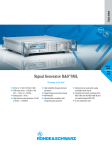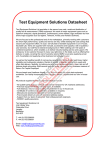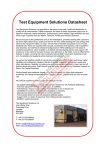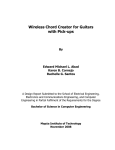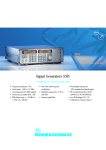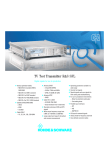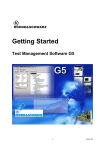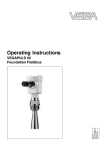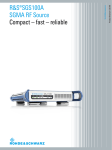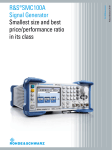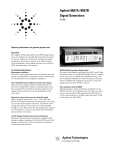Download Signal Generator R&S SML - DESY
Transcript
Signal Generator R&S SML Economy at its best ◆ 9 kHz to 1.1 GHz/2.2 GHz/3.3 GHz ◆ SSB phase noise: <−122 dBc (1 Hz) (at f = 1 GHz, ∆f = 20 kHz) ◆ Setting times <10 ms ◆ High level accuracy (deviation <0.5 dB at levels >−120 dBm) ◆ High reliability through electronic attenuator ◆ Digital frequency and level sweep ◆ AM/FM/ϕM ◆ Optional pulse modulator with integrated pulse generator ◆ 3-year calibration cycle Unequalled universality Frequency Spectral purity Low cost of ownership ◆ 9 kHz to 1.1 GHz/2.2 GHz/3.3 GHz ◆ 0.1 Hz frequency resolution ◆ SSB phase noise <−122 dBc (1 Hz), typ. −128 dBc (1 Hz) (f = 1 GHz, carrier offset 20 kHz) ◆ Broadband noise <−140 dBc (1 Hz), typ. −150 dBc (1 Hz) (f = 1 GHz, carrier offset >2 MHz) Speed ◆ 3-year calibration cycle ◆ Low purchase price ◆ High reliability through electronic attenuator (wear-free) ◆ Service-friendly (continuous selftest, access to internal test points) ◆ Options OCXO (R&S SML-B1) and pulse modulator (R&S SML-B3) retrofittable ◆ Setting times <10 ms for frequency and level Size Level ◆ −140 dBm to +13 dBm (+19 dBm overrange) ◆ High level accuracy (deviation <0.5 dB, at levels >−120 dBm) ◆ Level setting without overshoots ◆ Electronic attenuator ◆ Non-interrupting level setting Modulation ◆ AM/FM/ϕM as standard ◆ Simultaneous AM, FM/ϕM and pulse modulation ◆ Optional pulse modulator with integrated pulse generator (R&S SML-B3) 2 Signal Generator R&S SML ◆ Compact size: 427 mm x 88 mm x 450 mm ◆ Low weight: <8.5 kg Applications Lab and R&D: versatile High spectral purity Thanks to its low phase noise R&S SML is ideally suited to replace LOs. Versatile modulation modes R&S SML in conjunction with the optional Pulse Modulator R&S SML-B3 handles all analog types of modulation. AM, FM/ϕM and pulse modulation can be used simultaneously. TDMA signals or amplitude variations at FM, for example, can thus be simulated. High and precise output level R&S SML has plenty of power in reserve so level loss produced by the test setup can be easily compensated. Its high output level makes R&S SML an ideal source for driving high-level mixers. Excellent modulation characteristics The DC-coupled FM allows the R&S SML to be used as an accurate VCO. Example: receiver measurements ◆ Sensitivity measurements require a signal generator with high level accuracy. This is particularly true at low output levels. With its sophisticated calibration technique, R&S SML features high level accuracy (<0.5 dB at levels >−120 dBm). ◆ Squelch measurements call for continuous level setting. Non-interrupting level variation by typ. 30 dB makes R&S SML the ideal choice for squelch measurements. R&S SML offers all features required of a state-of-the-art general-purpose signal generator: wide frequency range, large variety of modulation functions and high reliability – at an extremely attractive price. The fields of application of R&S SML are virtually unlimited in development, servicing or production where it is used as a flexible signal source in automatic test systems. R&S SML benefits both from our long-standing experience in the field of signal generators and the latest technology. Its uses are as versatile as its functionalities. ◆ Low spurious, low broadband noise and above all excellent SSB phase noise are prerequisites for using a signal generator as an interference source. With typ. −128 dBc (1 Hz) SSB phase noise (at f = 1 GHz, ∆f = 20 kHz), spurious suppression of typ. −76 dBc and broadband noise of typ. −150 dBc (1 Hz), R&S SML easily meets even the most exacting requirements. ◆ The mechanical design of R&S SML ensures excellent RF shielding of its casing. This is particularly important for measurements on highly sensitive receivers with built-in antenna such as pagers. Signal Generator R&S SML 3 Applications (continued) Servicing: robust, compact, lightweight Mobility R&S SML is lightweight and compact and therefore very easy to transport. Flexible control In service environments, an IEC/IEEE interface is not always available for controlling the generator. This is no problem for R&S SML since it can also be driven via a standard RS-232-C interface. Protection against overvoltage The integrated overvoltage protection of the RF input protects the R&S SML against very high external voltages such as may occur during transceiver measurements. Production: fast, accurate, reliable Accuracy Measurement uncertainty can be split into the contribution from the instrument Level sweep within 25 dB range 4 Signal Generator R&S SML and that introduced by the test setup. With a smaller uncertainty of the generator, greater tolerances can be allowed for the setup. If the small level deviation of the analyzer is used to allow for higher DUT tolerances, the result will be a marked reduction in manufacturing rejects – an advantage that pays off immediately. nal is taken to the DUT via switches and cables, cause level losses which can be easily compensated by the high output power of R&S SML. Speed Speed is of prime importance in production. And this is exactly one of the strong points of R&S SML, with a setting time <10 ms for frequency and level. Example: component test Reliability A signal generator used in production must have high reliability. R&S SML meets this requirement for example through the use of a completely wear-free electronic attenuator. Should a fault nevertheless occur, the continuous self-diagnosis of R&S SML prevents expensive erroneous measurements. Output level Production test systems, in which the sig- Dimensions Space is often at a premium in production. The compact size of R&S SML makes it ideal for use in such environments. ◆ To obtain reliable information on component quality, high level accuracy and precise reproducibility of the output level are called for. R&S SML fully meets these requirements thanks to the level deviation of <0.5 dB (at levels >−120 dBm) and high reproducibility. ◆ With unrivalled short times (<10 ms) for frequency and level setting, R&S SML enables fast testing and is ideal for use in production. ◆ Overshoots in case of level change may damage or destroy the DUT. This cannot happen with R&S SML since it operates without any overshoots. Settling upon frequency change from 100 MHz to 1 GHz EMS measurements Non-interrupting level setting without overshoots EMS measurements call for noninterrupting level setting which should moreover be performed without any overshoots. R&S SML operates free of overshoots and offers a wide dynamic range of typ. 30 dB for non-interrupting level variation (with Attenuator Mode Fixed). Typical SSB noise at 1 GHz (with OCXO option R&S SML-B1) Wide frequency range R&S SML has a lower frequency limit of 9 kHz as standard and so fully covers the frequency range required for EMC measurements. Reference source R&S SML offers the option of selecting the mode of frequency generation. In the Extended Divider Range mode, the RF signal is generated by frequency division. The excellent values obtained in this mode for SSB phase noise are comparable with the high-grade crystal oscillators normally used as reference sources from 10 MHz to 30 MHz. Typical SSB phase noise versus carrier frequency (carrier offset 20 kHz); dashed line: Extended Divider Range mode Offset from carrier Compared to crystal oscillators, R&S SML provides the following benefits: ◆ Frequency can be set in 0.1 Hz steps and synchronized to an external reference ◆ All functions can be remotely controlled via the IEC/IEEE bus or serial interface SSB phase noise, typical values 1 Hz –95 dB 10 Hz –120 dB 100 Hz –130 dB 1 kHz –138 dB 10 kHz –148 dB SSB phase noise at 9.5 MHz output frequency, extended divider range activated, 1 Hz measurement bandwidth Turn EasyWheel ◆ One-hand operation with EasyWheel ◆ All settings simple and self-explanatory ◆ High-contrast LCD ◆ User-assignable menu keys ◆ Online help including IEC/IEEE-bus commands Click Simply select the desired menu with the spinwheel and click the button to open the submenu Signal Generator R&S SML 5 Specifications Specifications apply under the following conditions: 15 minutes warmup time at ambient temperature, specified environmental conditions met, calibration cycle adhered to, and total calibration performed. Data designated “nominal” apply to design parameters and are not tested. Data designated “overrange” are not warranted. Warranted specs do not apply to the Extended Divider Range mode. Frequency Level accuracy2) 4) (level >−120 dBm) R&S SML01 (for f>100 kHz) R&S SML02/SML03 100 kHz to ≤ 2 GHz f >2 GHz Frequency response at 0 dBm2) 4) R&S SML01 (for f>100 kHz) R&S SML02/R&S SML03 100 kHz to ≤ 2 GHz f >2 GHz Characteristic impedance Range 9 kHz to 1.1 GHz R&S SML01 R&S SML02 R&S SML03 9 kHz to 1.1 GHz 9 kHz to 2.2 GHz 9 kHz to 3.3 GHz Resolution 0.1 Hz Setting time (for an offset of <1x10−7 or <90 Hz for f ≤76 MHz) after IEC/ IEEE-bus delimiter VSWR R&S SML01 R&S SML02/03 100 kHz to 1.5 GHz f >1.5 GHz <10 ms Standard Option R&S SML-B1 Aging (after 30 days of operation) <1x10−6/year <1x10−7/year or <5x10−10/day Temperature drift (0°C to 55°C) <1x10−6 <2x10−8 Output for internal reference Frequency Output voltage, V rms, sinewave Source impedance 10 MHz >0.5 V into 50 Ω 50 Ω Input for external reference Frequency Permissible frequency drift Input voltage, V rms, sinewave Input impedance 10 MHz 5x10-6 0.5 V to 2 V into 50 Ω 50 Ω Spectral purity <−30 dBc at levels ≤+10 dBm <−30 dBc at levels ≤+8 dBm none <–50 dBc <–70 dBc <–64 dBc <–58 dBc Broadband noise2) (f = 1 GHz, carrier offset >2 MHz, 1 Hz bandwidth) <−140 dBc, typ. −150 dBc SSB phase noise (f = 1 GHz, 20 kHz carrier offset, 1 Hz bandwidth) <−122 dBc, typ. −128 dBc Spurious FM, rms (f = 1 GHz) 0.3 kHz to 3 kHz 0.03 kHz to 20 kHz <0.5 dB, typ. 0.3 dB <0.7 dB <1.0 dB 50 Ω <1.5 1.6 2.3 Non-interrupting level setting (for f>100 kHz)5) 20 dB, overrange 30 dB Overvoltage protection safeguards unit against externally applied RF power and DC voltage (50 Ω source) Max. permissible RF power f ≤2.2 GHz f >2.2 GHz 50 W 25 W Max. permissible DC voltage 35 V Internal modulation generator Frequency range Resolution 0.1 Hz to 1 MHz 0.1 Hz Frequency accuracy as for reference frequency + 2.4 x 10−3 Hz Frequency response (up to 500 kHz, level >100 mV) <0.5 dB THD (up to 100 kHz, level 4 V, RL = 600 Ω) <0.1% Open-circuit voltage Vp (LF connector) 1 mV to 4 V Resolution 1 mV Setting accuracy (at 1 kHz) 1% of VP+ 1 mV Output impedance Simultaneous modulation AM, FM/ϕM and pulse modulation Amplitude modulation6) Operating modes internal, external AC/DC, internal/external two-tone Modulation depth 0% to 100%, settable modulation depth continuously decreasing between +7 dBm and +13 dBm7) while adhering to AM specifications; a status message is output when modulation depth is too high Resolution 0.1% <4 Hz, typ. 1 Hz <10 Hz, typ. 3 Hz Level approx. 10 Ω Frequency setting time (after reception of last IEC/IEEE-bus character) <10 ms Spurious AM, rms (0.03 kHz to 20 kHz) <0.02% Setting accuracy at 1 kHz (m <80 %)8) <4% of reading +1% −140 dBm to +13 dBm2) 3) (overrange +19 dBm) Range Resolution 6 <0.5 dB <0.9 dB Setting time (IEC/IEEE bus), f >100 kHz <10 ms, typ. 5 ms Reference frequency Spurious signals Harmonics (for f>100 kHz)1) R&S SML01 R&S SML02/R&S SML03 Subharmonics f ≤1.1 GHz f >1.1 GHz Nonharmonics (carrier offset >10 kHz) f ≤1.1 GHz f >1.1 GHz to 2.2 GHz f >2.2 GHz to 3.3 GHz <0.5 dB Signal Generator R&S SML 0.1 dB AM distortion at 1 kHz m = 30% m = 80% <1% <2% Modulation frequency range (<3 dB) DC/10 Hz to 50 kHz Incidental ϕM at AM (30%), AF = 1 kHz Modulation input EXT Input impedance Input voltage Vp for set modulation depth <0.2 rad >100 kΩ 1V Frequency modulation Operating modes internal, external AC/DC, internal/external two-tone Rise/fall time (10%/90%) <20 ns, typ. 10 ns, Pulse repetition frequency 0 MHz to 2.5 MHz Pulse delay typ. 50 ns Video crosstalk (Vp) <30 mV Modulation input PULSE Input level Input impedance TTL level (HCT) 10 kΩ or 50 Ω, selectable with internal link Pulse generator (with option R&S SML-B3) Frequency deviation 9 kHz to 76 MHz >76 MHz to 151.3125 MHz >151.3125 MHz to 302.625 MHz >302.625 MHz to 605.25 MHz >605.25 MHz to 1.2105 GHz >1.2105 GHz to 1.818 GHz >1.818 GHz to 2.655 GHz >2.655 GHz to 3.300 GHz 0 MHz to 1 MHz 0 kHz to 125 kHz 0 kHz to 250 kHz 0 kHz to 500 kHz 0 MHz to 1 MHz 0 MHz to 2 MHz 0 MHz to 3 MHz 0 MHz to 4 MHz Operating modes automatic, externally triggered, external gate mode, single pulse, double pulse, delayed pulse (externally triggered) Active trigger edge positive or negative Pulse period Resolution Accuracy 100 ns to 85 s 5 digits, min. 20 ns <1 x 10−4 Resolution <1% of set deviation, minimum 10 Hz Setting accuracy (at AF = 1 kHz) <4% of reading + 20 Hz Pulse width Resolution Accuracy 20 ns to 1 s 4 digits, min. 20 ns <(1 x 10−4 + 3 ns) FM distortion (at AF = 1 kHz and 50% of max. deviation) <0.2%, typ. 0.1% Modulation frequency range (<3 dB), standard/wide Pulse delay Resolution Accuracy 20 ns to 1 s 4 digits, min. 20 ns <(1 x 10−4 + 3 ns) DC/10 Hz to 100 kHz/500 kHz Incidental AM (at AF = 1 kHz, f >10 MHz, 40 kHz deviation) <0.1% Double-pulse spacing Resolution Accuracy 20 ns to 1 s 4 digits, min. 20 ns <(1 x 10−4 + 3 ns) Trigger delay typ. 50 ns Jitter <10 ns PULSE/VIDEO output TTL signal (RL ≥50 Ω) Sweep digital in discrete steps Stereo modulation at 40 kHz useful deviation, AF = 1 kHz, RF = 87 MHz to 108 MHz Crosstalk S/N ratio unweighted, rms S/N ratio weighted, rms Distortion >50 dB >70 dB >70 dB <0.2%, typ. 0.1% Carrier frequency offset at FM DC typ. 0.1% of set deviation Modulation input EXT Input impedance Input voltage Vp for set deviation (nominal value) >100 kΩ Sweep range Step width (lin) Step width (log) 1V Level sweep Operating modes Phase modulation Operating modes RF sweep, AF sweep Operating modes internal, external AC/DC, internal/external two-tone Sweep range Step width (log) automatic, single-shot, manually or externally triggered, linear or logarithmic user-selectable user-selectable 0.01% to 100% automatic, single-shot, manually or externally triggered, logarithmic user-selectable user-selectable Phase deviation9) 9 kHz to 76 MHz >76 MHz to 151.3125 MHz >151.3125 MHz to 302.625 MHz >302.625 MHz to 605.25 MHz >605.25 MHz to 1.2105 GHz >1.2105 GHz to 1.818 GHz >1.818 GHz to 2.655 GHz >2.655 GHz to 3.300 GHz 0 rad to 10 (2) rad 0 rad to 1.25 (0.25) rad 0 rad to 2.5 (0.5) rad 0 rad to 5 (1) rad 0 rad to 10 (2) rad 0 rad to 20 (4) rad 0 rad to 30 (6) rad 0 rad to 40 (8) rad Resolution <1%, min. 0.001 rad System IEC 625 (IEEE 488) and RS-232 Setting accuracy at AF = 1 kHz <4% of reading + 0.02 rad Command set SCPI 1995.0 Connector Amphenol, 24-pin and 9-pin IEC/IEEE-bus address 0 to 30 Interface functions SH1, AH1, T6, L4, SR1, RL1, PP1, DC1, DT1, C0 Phase distortion (at AF = 1 kHz and 50% of maximum deviation) <0.2%, typ. 0.1% Modulation frequency range (–3 dB), standard/wide DC/10 Hz to 100 kHz/500 kHz Modulation inputs EXT Input impedance Input voltage Vp for set deviation (nominal value) >100 kΩ Step time Resolution Memory for device settings Storable settings 1) 3) 4) 5) Pulse modulation (with option R&S SML-B3) Operating modes internal, external On/off ratio >80 dB 100 Remote control 2)) 1V 10 ms to 1 s 0.1 ms 6) 7) 8) 9) With option R&S SML-B3 only for f > 20 MHz. With Attenuator Mode Auto. –140 dBm to 11 dBm at f ≤5 MHz, f >3 GHz. Temperature range 20°C to 30°C. With Attenuator Mode Fixed. With Attenuator Mode Auto, f ≥100 kHz. +5 dBm to 11 dBm at f ≤5 MHz, f >3 GHz. With option R&S SML-B3 only for f >10 MHz. Values in brackets apply to wide modulation bandwidth. Signal Generator R&S SML 7 Specs complied with between 0 °C and 55 °C; meets IEC68-2-1 and IEC68-2-2 Storage temperature range −40°C to +70°C Signal Generator R&S SML01 R&S SML02 R&S SML03 Accessories supplied power cable, user manual Climatic resistance Damp heat 95% relative humidity at +25 °C/ +40 °C cyclically; meets IEC68-2-3 Options Reference Oscillator OCXO Pulse Modulator Rear Connectors for AF, RF 5 Hz to 150 Hz, max. 2 g at 55 Hz, max. 0.5 g between 55 Hz and 150 Hz, meets IEC68-2-6, IEC1010-1 and MIL-T-28800D, class 5 Recommended extras Service Kit 19“ Rack Adapter Transport Bag Service Manual, Modules Mechanical resistance Vibration, sinusoidal Vibration, random 10 Hz to 300 Hz, acceleration 1.2 g (rms) Shock 40 g shock spectrum, meets MIL-STD-810D and MIL-T-28800D, class 3/5 Electromagnetic compatibility 1090.3000.11 1090.3000.12 1090.3000.13 R&S SML-B1 R&S SML-B3 R&S SML-B19 1090.5790.02 1090.5403.02*) 1090.5303.02*) R&S SML-Z2 R&S ZZA-211 R&S ZZT-214 1090.5203.02 1096.3260.00 1109.5119.00 1090.3123.24 Printed in Germany Temperature loading 0202 (Bi bb) Ordering information General data *) Factory-fitted only. meets EN 50081-1 and EN 50082-1 (EMC directive of EU) Susceptibility to radiated interference 10 V/m Power supply 100 V to 120 V (AC), 50 Hz to 400 Hz, 200 V to 240 V (AC), 50 Hz to 60 Hz, autoranging, max. 150 VA Safety meets DIN EN 61010-1, IEC 1010-1, UL 3111-1, CSA 22.2 No. 1010-1 Certified Environmental System Dimensions (W x H x D) 427 mm x 88 mm x 450 mm Weight 8.5 kg when fully equipped ISO 14001 ISO 9001 DQS REG. NO 1954 ROHDE&SCHWARZ GmbH & Co. KG ⋅ Mühldorfstraße 15 ⋅ 81671 München ⋅ Germany ⋅ P.O.B. 8014 69 ⋅ 81614 München ⋅ Germany ⋅ Telephone +49894129-0 www.rohde-schwarz.com ⋅ Customer Support: Tel. +491805124242, Fax +4989 4129-13777, E-mail: [email protected] PD 0757.5550.24 ⋅ Signal Generator R&S SML ⋅ Trade names are trademarks of the owners ⋅ Subject to change ⋅ Data without tolerances: typical values REG. NO 1954 Certified Quality System








